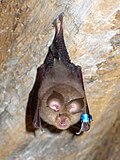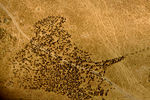bat, at 10 cm (4 in) plus a 5 cm (2 in) tail. Like all bats, rhinolophids are capable of true and sustained flight, and have wing lengths ranging from...
92 KB (3,192 words) - 00:25, 6 September 2024
Horseshoe bat (redirect from List of Rhinolophus species)
the rhinolophids can be split into two major clades: the mostly African clade, and the mostly Oriental clade. The most recent common ancestor of Rhinolophus...
56 KB (5,930 words) - 09:56, 20 October 2024
The following is the list of mammals which have been taxonomically described in the 21st century. List of mammals described in the 2000s...
259 KB (23 words) - 14:12, 27 July 2024
Greater horseshoe bat (category IUCN Red List least concern species)
structures that are distinct from that of other rhinolophids. Its first premolar on the upper jaw protrudes from the row of teeth. For other horseshoe bats,...
18 KB (2,418 words) - 03:16, 8 October 2024
Hipposideridae (section List of species)
2015). "How and Why Overcome the Impediments to Resolution: Lessons from rhinolophid and hipposiderid Bats". Molecular Biology and Evolution. 32 (2): 313–333...
16 KB (1,681 words) - 15:31, 27 July 2024
Three families of Chiroptera are present in Cantabria: the molossids, the rhinolophids or horseshoe bats and the vespertilionids. Of all of them, the most...
87 KB (3,336 words) - 16:43, 14 July 2024
Mammal classification (redirect from Classification of mammals)
Bumblebee bat or Kitti's hog-nosed bat Rhinolophoid bats Horseshoe bats (rhinolophids) Hollow-faced or slit-faced bats (nycterids) False vampires (megadermatids)...
76 KB (6,393 words) - 21:36, 28 September 2024
Messel, the two species of Palaeochiropteryx are hypothesized to have occupied similar niches to living hipposiderids and rhinolophids that forage close to...
12 KB (1,023 words) - 01:21, 27 April 2024
Rhinonycteridae (category Bats of Australia)
for this family by the authors of the 2014 revision that elevated this taxon. The hipposiderid and rhinolophid bats are of especial interest to research...
9 KB (928 words) - 02:17, 28 August 2024
(Lamontagne) amanitin (Hathwar) chalazion (Upadhyayula) hypozeuxis (Janga) rhinolophid (Kumar) ptyalism (Lamontagne) calamistrum (Hathwar) theriaca (Upadhyayula)...
12 KB (865 words) - 05:42, 15 July 2024
characterization of rhinolophid species". Journal of Zoology. 256 (2): 165–179. doi:10.1017/S0952836902000201. Parnaby, H.E. (2002). "A taxonomic review of the genus...
35 KB (3,212 words) - 14:17, 27 July 2024
2015). "How and Why Overcome the Impediments to Resolution: Lessons from rhinolophid and hipposiderid Bats". Molecular Biology and Evolution. 32 (2): 313–333...
4 KB (414 words) - 02:05, 28 August 2024
Orange leaf-nosed bat (category IUCN Red List least concern species)
2015). "How and Why Overcome the Impediments to Resolution: Lessons from rhinolophid and hipposiderid Bats". Molecular Biology and Evolution. 32 (2): 313–333...
12 KB (1,296 words) - 03:27, 30 December 2023
Smaller horseshoe bat (category IUCN Red List least concern species)
Rhinolophus megaphyllus is a small rhinolophid bat that has a combined head and body length of 44–53 millimetres, with a measurement of the forearm an approximately...
8 KB (970 words) - 23:44, 14 August 2024
David Hayman (disease ecologist) (category Alumni of the University of Cambridge)
might inform the prediction of the most likely source of the next possible coronavirus pandemic. The spread of rhinolophid bats was mapped across the world...
53 KB (5,183 words) - 12:23, 6 August 2024











